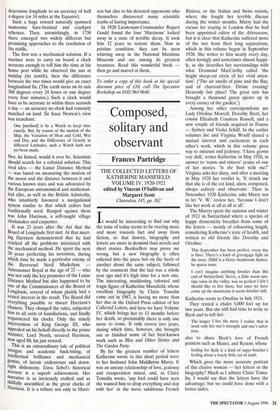Composed, solitary and observant
Frances Partridge
THE COLLECTED LETTERS OF KATHERINE MANSFIELD: VOLUME IV, 1920-1921 edited by Vincent O'Sullivan and Margaret Scott
Clarendon, £45, pp. 362
It would be interesting to find out why the taste of today seems to be veering more and more towards fact and away from fiction, so that history, biography and letters are more in demand than novels and short stories. Booksellers may prove me wrong, but a new biography is often ushered into the press hot on the heels of another about the same subject, followed by the comment that the last was a whole year ago and it's high time for a new one. The interesting, maddening, talented and tragic figure of-Katherine Mansfield, whose excellent biography by Claire Tomalin came out in 1987, is having no more than her due in the Oxford Press edition of her Collected Letters, and here we have Volume IV, which brings her to 13 months before her death, so presumably there is only one more to come. It only covers two years, during which time, however, she brought out or finished some of her best-known work such as Bliss and Other Stories and The Garden Party.
By far the greatest number of letters Katherine wrote in this short period were to her husband John Middleton Murry. It was an uneasy relationship of love, jealousy and exasperation mixed, and, as Claire Tomalin wrote, any fool could have seen she wanted him to drop everything and stay with her' in the more salubrious French
Riviera, or the Italian and Swiss resorts, where she fought her terrible disease during the winter months. Murry had the excuse for staying in London that he had been appointed editor of the Athenaeum, but it is clear that Katherine suffered more of the two from their long separations, which in this volume began in September 1920. She writes to him nearly every day, often lovingly and sometimes almost happi- ly, as she describes her surroundings with what Desmond MacCarthy called 'the bright sharp-cut circle of her vivid atten- tion'. ('The air smells of pine and the Bay, and of charcoal-fires. Divine evening! Heavenly fair place! The great rain has brought a thousand green spears up in every corner of the garden.') Among her other correspondents are Lady Ottoline Morrell, Dorothy Brett, her cousin Elizabeth Countess Russell, and a new couple of friends acquired in France — Sydney and Violet Schiff. In the earlier volumes she and Virginia Woolf shared a mutual interest and excitement in each other's work, which in this volume gives way to mistrust and jealousy. 'I have grown very dull,' writes Katherine in May 1920, in answer to 'warm and sincere' praise of one of her stories. 'Is she hurt with me?' Virginia asks her diary, and after a meeting in May 1920 her verdict is, 'It struck me that she is of the cat kind, alien, composed, always solitary and observant.' Then in November 1920 Katherine asks Murry not to let 'V. W.' review her, 'because I don't like her work at all at all at all'.
The Murrys spent the autumn and winter of 1921 in Switzerland where a species of happy domesticity breathes from some of the letters — mostly of exhausting length, considering Katherine's state of health, and written to old friends like Dorothy and Ottoline.
This September has been perfect, every day is finer. There's a kind of greengage light on the trees. JMM is a fierce mushroom hunter, he spares none.
I can't imagine anything lovelier than this end of Switzerland. Sierre, a little warm sun- ripe town in the valley, was so perfect I felt I should like to live there, but once we have come up the mountains it seems lovelier still,
Katherine wrote to Ottoline in July 1921. They rented a chalet 5,000 feet up for two years. But she still had time to write to Brett and to tell her:
The longer I live the more I realise that in work only lies one's strength and one's salva- tion,
also to share Brett's love of French painters such as Manet, and Renoir, whose
feeling for flesh is a kind of super-butcher's feeling about a lovely little cut of lamb.
Which gives the more accurate portrait of this elusive woman — her letters or the biography? Much as I admire Claire Toma- lin, I would say that the letters have the advantage; but we could have done with a better index.


















































 Previous page
Previous page